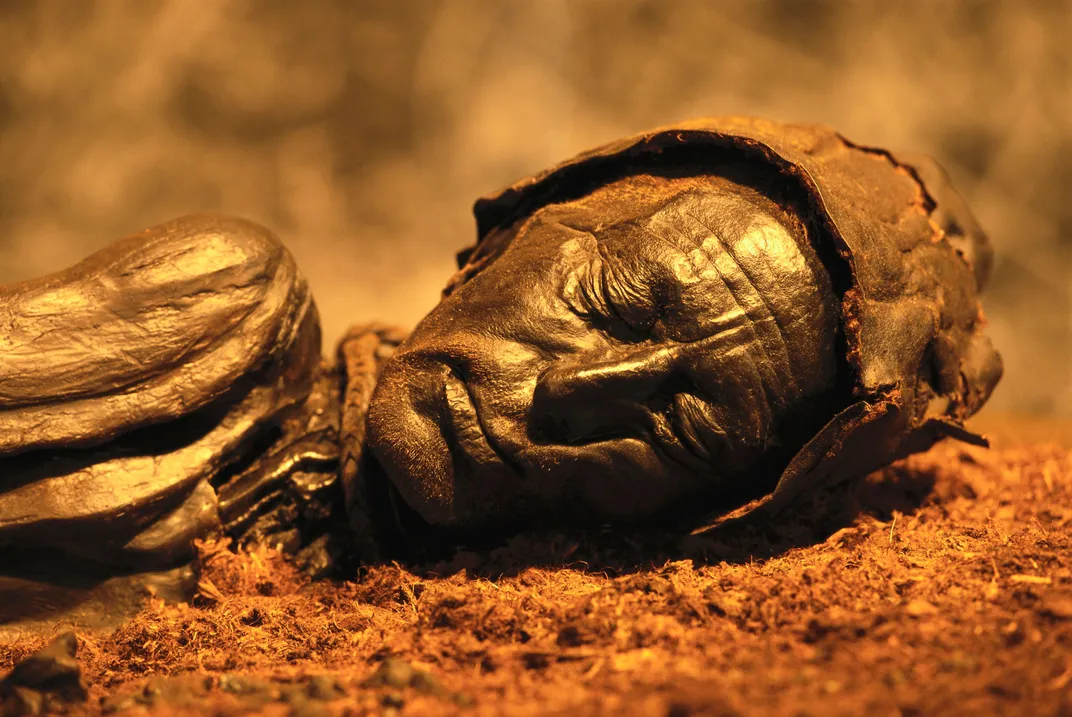Mummies May Have Been Scattered Across Bronze Age Britain
Skeletal analysis hints that, intentional or not, mummification may have been more common than previously thought
/https://tf-cmsv2-smithsonianmag-media.s3.amazonaws.com/filer/e0/72/e0726111-250a-4fb5-b0ea-325edb675a94/bradley_fen_sk_853_-credit_cambridge_archaeological_unit40.jpg)
The classic mental image of a mummy comes via ancient Egypt, where specialists ritually removed organs and tightly wrapped bodies in bandages to preserve rulers and nobles and allow them passage to the afterlife. But around 4,000 years ago, while these elaborate death rituals were in full swing, a different kind of mummy may have been taking shape in Bronze Age Britain.
A pair of well-preserved bodies dating back to around 1300 and 1600 B.C. was discovered in 2001, entombed beneath an ancient dwelling in Cladh Hallan, Scotland. Intriguingly, these bodies seem to have been intentionally mummified.
Carbon dating shows that the bones were not buried for hundreds of years after their initial death. But the skeletal remains are surprisingly intact, and the bones show an unusually minimal state of decomposition. That suggests they must have been preserved in some way, perhaps by being pickled in a peat bog.
The find prompted Thomas Booth of the Natural History Museum in London to wonder whether mummification was more widespread in ancient Britain than previously assumed.
The problem with British mummies is identifying them out of a skeletal lineup. Mummification methods available in Bronze Age Britain would have been rudimentary—such as smoking bodies over a fire or brining them in a bog.
While these techniques can preserve some soft tissues for a time, most British mummies would have become nothing but bones over the centuries. Unlike Egyptian mummies, who were often trussed up in elaborate coffins in the desiccated desert, British mummies were buried comparatively au natural in a more temperate environment.
So how do you tell a British mummy from a non-mummy? The answer lies in the tiny holes within the bones.
“After you die, the gut bacteria that you’ve been steadfastly aggregating break free,” says Booth. These bacteria will attack the bones, riddling them with holes. Mummification either slows or prevents this process altogether, so mummified bodies will have less hole-ridden bones.
Armed with this analysis method, Booth and his colleagues set out on a mummy hunt, examining paper-thin slices of bones from 301 historical skeletons collected from 24 British sites and one Swedish site.
The scientists discovered that bones from the majority of the skeletons dated to the Neolithic period and more recent times were like Swiss cheese, riddled with holes. Only three percent of these remains showed evidence of pre-burial preservation.
But almost half of the Bronze Age skeletons—16 out of 34—from across Britain appeared to have been preserved, the team reports this week in the journal Antiquity.
Booth notes that the Cladh Hallan bodies are franken-mummies consisting of a bizarre assembly of bones taken from multiple individuals. This hints that their mummification may have had some ritual significance.
But while mummification in popular culture usually implies cultural intent, that isn’t always the case, says David Hunt, the physical anthropology collections manager at the Smithsonian National Museum of Natural History. These bodies could have been unintentionally preserved through natural processes.

There have been many instances of accidental mummification—the bog bodies of Denmark, the copper-masked mummies of Siberia and Ötzi the Iceman from the Alps, to name a few. And particular soil chemistries or burial methods, like shrouding the dead with moss, may change conditions just enough to slow putrefaction and preserve the bones, says Hunt.
Also, the reasons for intentional mummification vary widely between societies. The Inca, for instance, mummified their rulers to allow them to remain at their posts, while some Buddhist monks may even self-mummify to achieve the ultimate state of enlightenment. But with a lack of associated burial artifacts, it's unclear what would have motivated Bronze Age Britons to mummify their dead.
Booth hopes to continue his mummy hunt at other sites throughout Europe using a broader battery of analyses to determine exactly how the bones were preserved. And future studies may yet reveal more about how and why the 16 British bodies became mummies, perhaps offering a new window into the funerary practices of the Bronze Age.
/https://tf-cmsv2-smithsonianmag-media.s3.amazonaws.com/accounts/headshot/Wei-Haas_Maya_Headshot-v2.png)
/https://tf-cmsv2-smithsonianmag-media.s3.amazonaws.com/accounts/headshot/Wei-Haas_Maya_Headshot-v2.png)